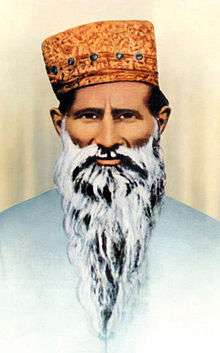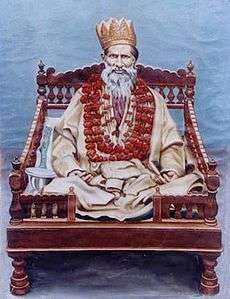Shiv Dayal Singh
Shiv Dayāl Singh Seth, called by the honorific "Param Purushh Puran Dhani Huzur Soamiji Maharaj" by his disciples and devotees, was born on 24 August 1818 in Agra in the colonial era British India (present-day Agra, Uttar Pradesh, India), and died on 15 June 1878 in the same city. His parents were followers of a spiritual guru Tulsi Saheb. Shiv Dayal Singh founded the Radhasoami movement – a 19th-century spiritual faith.[1]
Shiv Dayāl Singh Seth | |
|---|---|
 | |
| Other names | Param Purushh Puran Dhani Huzur Soamiji Maharaj (honorific used by devotees) |
| Personal | |
| Born | 24 August 1818 Panni Gali, Agra, Ceded Provinces, British India |
| Died | 15 June 1878 (aged 59) Panni Gali, Agra, North-Western Provinces, British India |
| Religion | Sant Mat, Radhasoami |
| Sect | Uttari Bharat ki Sant Parampara (Sant Tradition of North India) |
| Other names | Param Purushh Puran Dhani Huzur Soamiji Maharaj (honorific used by devotees) |
| Senior posting | |
| Period in office | 1861-1878 |
| Successor | Salig Ram, Jaimal Singh garib das |
Early life
The parents of Shiv Dayāl Singh were residents of Punjab, but moved to Agra at the behest of the colonial British government who had set up a major military center there and relied heavily on Sikhs from the Punjab region to staff the base.[2] At the age of five, Shiv Dayāl Singh was sent to school where he learnt Hindi, Urdu, Persian and Gurumukhi, Arabic and Sanskrit. His father, Dilwali Singh Seth was a Sahejdhari Khatri.[3][4]His family including his father, mother, mother-in-law, sister and his wife Nārāini Devi (called "Rādhāji" by followers and devotees) were followers of Guru Nanak, which would make then Nanakpanthis or Sikhs, states Mark Juergensmeyer.[5] In addition, during Singh's childhood, the family also sought the spiritual tutelage of a local living guru named Sant Tulsi "Saheb" of Hathras, India.[5]
Adulthood
His marriage to Nārāini Devi (later called "Rādhāji" by followers and devotees), daughter of Izzat Rai of Faridabad was arranged at an early age. After Shiv Dayāl Singh completed his education, he became a Persian language translator to a government officer.[5] He left the job and became a teacher of Persian language. Once his brother gained an employment at Indian post office, he left his Persian language job, and joined his father's moneylending business. He spent increasing amount of his time, to religious pursuits. He began giving spiritual discourses based on the scriptures of Sikhism and writings of Tulsi Sahib.[5]
Practice
After the death of Sant Tulsi in 1843, Shiv Dayāl Singh practiced Surat Shabd Yoga for 15 years in almost total seclusion in a room within a room. He started holding Satsang (spiritual discourse) publicly on Vasant Panchami (a spring festival) in 1861, and continued for 17 years. Thus Basant Panchami is a very special day for the followers of the Radhasoami Faith.
Teachings
Shiv Dayāl Singh originally referred to the Supreme Being with the names "Sat Nām" (True Name) and "Anāmi" (Nameless). The term Rādhāsoāmi ("Rādhā"="Soul" and "Soami"="Lord", hence "Lord of the Soul") was used after Salig Rām became a disciple. On the request of Salig Ram, Shiv Dayāl Singh declared Satsang open on Basant Panchami Day on 1861.[6] The yoga system taught by Shiv Dayāl Singh is known as Surat Shabd Yoga.
Shiv Dayāl Singh described the secret of the True Name (Sat Nam).


His bani (poetical compositions) and sayings from satsang were published in two books after he died. Both are called Sār Bachan or Sār Vachan (meaning 'essential utterances') :[7][8][9]
- Sār Vachan Vartik (Sar Bachan in prose)
- Sār Vachan Chhand Band (Sar Bachan in verse)
Sār Vachan Vartik is in two parts: part one being an introduction written by Salig Ram and part two compiled of notes taken from the discourses of Shiv Dayāl, which he delivered in satsang up to 1878. They cover important teachings of the faith. His poems in Sār Vachan Chhand Band are replete with emotional appeal - a successful blending of popular poetic expressions from different languages of north India such as, Khari-Boli, Awadhi, Brijbhasha, Rajasthani and Gurumukhi.
Salig Ram
After Shiv Dayal Singh died, several persons took over as guru. One of them, Salig Ram (honorific: "Huzur Maharaj") served the Radhasoami Faith as the second Sant Satguru.
Salig Ram had three successors: his son Ajodhya Prasad who continued satsang at Salig Ram's home Huzuri Bhavan in Pipal Mandi, Brahm Shankar Misra who established the Radhasoami Central Administrative Council at Soami Bagh, and Shivbratlal in Mirzapur.
Soami Bagh and Dayal Bagh
The locality called "Soami Bagh" ("Soami's Garden"), the former home of Shiv Dayal Singh and the present location of his tomb-shrine, is currently owned and controlled by the twin organizations known as the Radhasoami Satsang Central Administrative Council and the Radhasoami Trust (called "the Council and the Trust" for short). Its across-the-street neighbor "Dayal Bagh" ("Dayal's Garden") is owned and controlled by the organization Radhasoami Satsang Dayalbagh Sabha. Dayal Bagh and its founder-guru Sir Anand Swarup, Kt. were broadcast to the Western public by Paul Brunton in his famed A Search in Secret India. Sir Anand Swarup received a knighthood for the massive social construction work performed at Dayal Bagh. The two organizations, Council/Trust and Dayalbagh, are both existent and functioning. The major dispute between the two groups is due to two divergent views: The members of Council/Trust claim that Council/Trust is the "parent stock" of Radhasoami faith. The members of Dayalbagh Sabha want access to the tomb-shrine of the revered Shiv Dayal Singh. The tomb-shrine (called ‘Samadh’), was build over 100 years by efforts of the Council/Trust. Soami Bagh Council/Trust allows all satsangis and tourists to visit Samadh, but doesn’t allow religious processions in the Holy Samadh from anyone outside the Council/Trust. In this light, Dayalbagh Sabha organised "SPIRICON 2010", a conference of various organizations who revere Shiv Dayal Singh (boycotted by Council/Trust), to promote mutual respect and to petition access to the tomb-shrine of supreme guru Shiv Dayal Singh.
References
- Mark Juergensmeyer (1991). Radhasoami Reality: The Logic of a Modern Faith. Princeton University Press. pp. 15–19, 38–42 with footnotes. ISBN 0-691-01092-7.
- Mark Juergensmeyer (1991). Radhasoami Reality: The Logic of a Modern Faith. Princeton University Press. pp. 15–16 with footnotes. ISBN 0-691-01092-7.
- Jivan Charitar Hazur Maharaj by Ajodhyā Parshād, p. 36.
- Jivan Charitar Soāmiji Mahārāj by Partap Singh Seth, p. 6.
- Mark Juergensmeyer (1991). Radhasoami Reality: The Logic of a Modern Faith. Princeton University Press. pp. 16–17 with footnotes. ISBN 0-691-01092-7.
- The Radhasoami Tradition by David C. Lane. Garland Publishing, Inc., New York, 1992. Archived 2011-05-17 at the Wayback Machine
- Radhasoamisatsang.org: Books by Swami ji Maharaj
- Radhaswamidinod.org: Books by Swami ji Maharaj Archived 2008-10-08 at the Wayback Machine
- "I have a book in my collection called the Sar Bachan written by Sardar Seva Singh, which is the teachings of the Sound Current, and acts as practically my Bible!" —Paul Twitchell in a letter to future wife Gail, 8 July 1963; in Paul Twitchell, Letters to Gail, volume II, Menlo Park: ECKANKAR, 1977, page 149. ("Sardar" Seva Singh was the Radha Soami Satsang Beas translator of the Sar Bachan into English.)
External links
- http://www.radhasoamisatsang.org
- https://web.archive.org/web/20080410220324/http://www.radhaswamidinod.org/faith.htm
- http://www.aors-dbbs.org/index.html
- http://www.sikh-heritage.co.uk/movements/radhasoamis/The%20radhasoamis.htm
- http://malankazlev.com/kheper/topics/chakras/chakras-SantMat.htm
- https://web.archive.org/web/20080509170243/http://www.seekersway.org/seekers_guide/radhasoami_1_g.html
- http://www.radhasoami-faith.info/Books_Frame.shtml
- Radha Soami Satsang Beas
- Science of the Soul
- Sant Mat - Surat Shabd Yoga: Contemporary Guru Lines & Branches
- http://radhasoamidayal.net/GuruIntro.html
- http://eacharya.inflibnet.ac.in/data-server/eacharya-documents/548158e2e41301125fd790cf_INFIEP_72/110/ET/72-110-ET-V1-S1%5B%5D